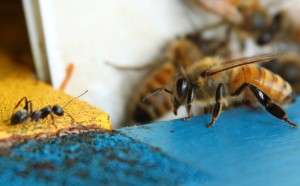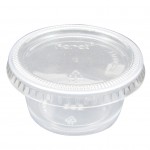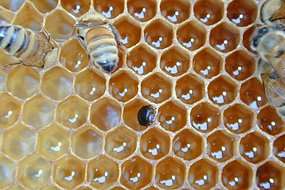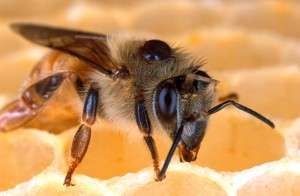Russian Bee Pests and Attacks

Ants & Earwigs
The Russian Bee Pests and Attacks are first seen by an invasion of ants followed by and invasion of earwigs. The generally accepted management technique is prevention not restoration of an infected colony. Ants reproduce at a horrific rate and will out number bees quickly.
We tried eradicating the ants with various methods; diatomaceous earth, tanglefoot, cinnamon, standing the hive legs in oil, and a seek and destroy mission in the evening to dig out ant hills from the bee yard. Digging out the ant hills was the most labor intensive but seemed to work the best. The yard looked like a mine field and the lawn tractor had to dodge all the pot holes.

A saturated borax solution was used mixing it in a 1:1 ratio by volume with a saturated sugar solution. Borax is sodium tetraborate and is available at the grocery store as a laundry aid. It is marketed as 20 Mule team borax. A little goes a long way since it is about 4% soluble in water. The mixture is highly toxic to carpenter ants.
The mixture was placed into a disposable plastic cup. A hole was placed in the cover that is larger than the ants but too small to let a honey bee in. The cups were placed above the inner cover with an empty shallow super above the inner cover followed by the outer cover. The ants like to move to the top of the hive and lay eggs in the crevasses of the inner cover. The mixture will kill the ant colony but the method is too slow. All methods have various disadvantages and do not yield complete eradication. The farm will test the use of cedar chips around the hives during the 2013 bee season.
Hive Beetles

Dr. Denis Anderson
Journal of Economic Entomology Russians have a better resistance to small hive beetles than the Italian breed. During each observation period, the average number of invading beetles was higher in the Italian colonies (29. 5 beetles) than in the Russian honey bee colonies (16.3 beetles).
deGuzman shows that Russians have a heightened aggressiveness toward SHB. Both stocks removed significantly more dead beetles (Russian = 67%, Italian = 57%) than live beetles (Russian = 13%, Italian = 0). Russian honey bees also removed live beetles (4.01 ± 1.96 min) as fast as the Italian bees removed dead beetles (4.30 ± 1.11 min).
Trachael Mites
SMF has not had any incidence of tracheal mites. Tracheal mite populations, according to De Guzman’s research “remained very low in Primorsky colonies regardless of the management tools employed. Several conclusions are apparent: 1) The ARS Primorsky honey bees tested exhibited strong resistance to tracheal mites and do not require treatment for tracheal mite control.”
Varroa Mites,

The farm uses an integrated pest management system (IPM); a screened bottom board, and monitoring mite loads every 10 days during normal hive inspections. Mites attach themselves to the drone larvae on day 8, before the cells are capped. A drone frame is placed in the brood box and replaced with an empty drone frame after the drone brood is capped. A drone cell is approximately 6.125 mm and larvae protrudes the cell whereas a worker cell is 4.9 mm and appears somewhat flat. Mite loads have been extremely low using these two methods along side a Russian Bee that is already Varroa resistant.
Hive splits can be timed so that Varroa mites self destruct. A break in the brood cycle by the removal of the queen, either temporarily or by a hive split will naturally rid the hive of most mites. Please see Hive Splits for a more in-depth discussion of how hive splits help to control Varroa mites. (Next Additional Observations)
